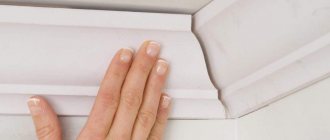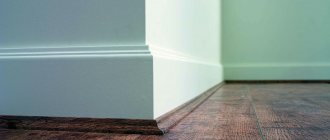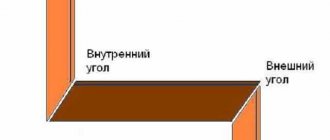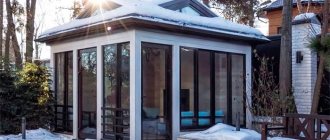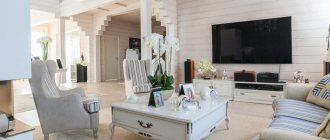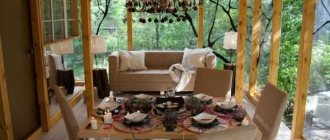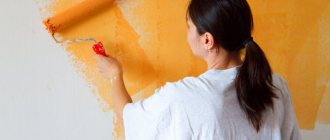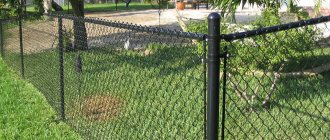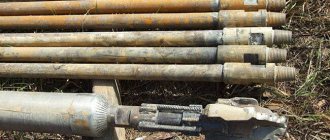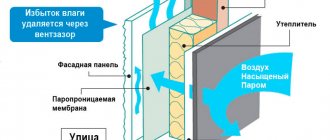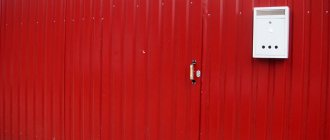Installation features
Manufacturers produce fittings for plastic profiles that allow easy and simple installation of products: connecting elements for two slats, side plugs (left and right are supplied in pairs) and external and internal corners.
They are not included in the scope of delivery of the skirting boards; they are purchased separately and you need to calculate their number in advance. The plinth in the corners, joints and plugs is inserted 3-5 mm, so in the corners it is cut flush with the wall. Advice. When counting the plugs, do not forget that they are installed in places where the profile adjoins the doorway and where direct installation is impossible for some reason.
There are two ways to install a plastic plinth: with hidden clips or with dowel screws.
The tools you will need are a hammer drill (for stone and concrete walls), a screwdriver, a hacksaw, a tape measure and a pencil.
Before installation, the shade of each slats is checked - even in the same package, shades may differ. It is recommended to install slats of a darker shade opposite the light source so that the difference is invisible.
Mounting clips are installed around the perimeter of the room every 400-500 mm and secured to the wall with dowel screws. The clips must be installed in one line, then the profile snaps onto them easily. This method is recommended to be used only in rooms with smooth walls.
The simplest and most common way to install a plastic profile is to attach it to the wall using dowel screws. To do this, through holes are drilled in the plinth every 300-500 mm. In a profile with a cable channel, the fastening point will be covered with a decorative strip; in a solid baseboard it is hidden with a plug in the color of the product.
Experts recommend gluing the joints of slats and corners, because when cleaning a room they have a habit of “flying off” from a mop or vacuum cleaner.
How to make skirting boards if the wall is made of plasterboard
Scheme for attaching a plinth to a plasterboard wall.
The height of the metal profile for plasterboard is approximately 30 - 50 mm. When installing skirting boards, you often have to deal with a situation where the fastening of the slats bumps into the profile. In this situation, the dowels should be replaced with self-tapping screws. But first you will need to drill the frame with a drill or use special dowels with drills designed for such situations. By using an awl, you can avoid a collision with the profile. To do this, just pierce the drywall with it.
Related article: How to make glue with your own hands
Polyurethane skirting
The mechanical properties of polyurethane plinth depend on the properties and combination of its constituent polymers. You can select a rigid polyurethane profile and a flexible one (Flex).
In addition to resistance to mechanical damage and moisture resistance, the polyurethane profile is distinguished by its low weight, ease of installation and maintenance. Polyurethane plinth can be used in all rooms of the apartment.
Polyurethane profiles are produced painted or prepared for painting.
Advice. It is recommended to paint the installed polyurethane profile one day after installation. The walls and floor are covered with masking tape. For painting, it is advisable to use aerosol acrylic paints in cans.
The cost of polyurethane products is higher than that of PVC profiles. This is justified by their best decorative and operational properties.
Recently, skirting boards (and other products) made of duropolymer have appeared on the market. It is produced from polystyrene foam under high pressure. Products made from duropolymer are particularly durable - they are not afraid of mechanical damage. Flexible duropolymer skirting boards are also produced.
Flexible polyurethane skirting boards (Flex) are made with rubber added to polyurethane. They used to say “rubber boy,” noting his extraordinary flexibility. Likewise, the Flex profile ensures the bending of products along a radius of 0.5 m. Each polyurethane product in the manufacturer’s line is repeated with a Flex product.
Varieties
Before we move on to analyzing the question of how to properly make a plinth, let's look at all the most commonly used variations.
There is simply no point in loading your head with absolutely all technologies, so we will consider only the most effective ones.
So, there is a small list of varieties:
The classic option is a plinth made of solid wood. As for the price of this product, everything is simple, it all depends only on the type of wood and the level of its processing.
Such items can be found in the catalog of some elite goods, or in the average price niche.
The main and most commonly used option is natural plinth made from inexpensive wood. These are, as a rule, coniferous tree varieties.
In some designs, the main element is laminated veneer lumber. After the plinth is formed, more expensive types of wood are glued onto it. The result is a product that is very similar to an expensive design.
Before installing skirting boards, you need to make a final choice.
Recommendation! If you are interested in the question of how to make a ceiling plinth, look for additional information on the Internet. In general, the process of installing ceiling skirting boards is quite different from installing conventional ones.
How to install a polyurethane profile
When installing polyurethane baseboards in corners, you need to cut them with a hacksaw - no fittings are available for them. Therefore, for work, in addition to a hacksaw for metal, a tape measure, a square, and a sealant gun, you will also need a miter box.
It is recommended to start work from the corner of the room. First, the corners in the room are checked with a square. Usually the plinth is cut at an angle of 45°. The accuracy of the joining of two slats must be checked before installation.
Important! For installation, try to choose adhesive putty from the same manufacturer. The glue is packaged in special cartridges. You can use liquid nails and styrofoam glue.
The glue is applied in two strips so that when pressed it fills the entire back side of the rail. To better press the product to the wall, you can attach it with furniture nails, then covering their heads with sealant.
The flexibility of the polyurethane plinth allows it to be pressed tightly against an uneven wall surface. For laying wires, polyurethane products have special grooves on the back side.
Do-it-yourself floor plinth installation
Make holes on the slats for self-tapping screws using an awl.
Many craftsmen advise first of all to make holes in the baseboards, along which to subsequently drill the surface on the wall. But, as practice shows, this installation method leaves gaps between the floor and the baseboard. In addition, if over time you want to change, for example, the floor covering, dismantling the slats will be quite difficult.
In order to perfectly install the bar without leaving any gaps, you can use the following method, which few people know. The holes on the slats for the screws should be pierced with an awl. By avoiding drilling, you will ensure that the edges of the hole are as tight as possible. An awl can be made from an old screwdriver by sharpening its blade to a triangular point.
To avoid making a mistake with the location for the hole in the baseboard, place it against the surface of the wall so that the dowel is visible. Make a mark exactly along the line where it is located at the place under which the cable channel is located. Then thread the self-tapping screw through the finished hole into the dowel and tighten it. This method of installing the plinth ensures its strong and reliable fastening, in addition, it leaves a minimum of gaps.
It is very important that the outer corners on the baseboards are secured as tightly as possible, since they are the most likely to be touched. When installing them, be careful, because often drilling a hole for a dowel ends with a chipped corner. In conclusion, all that remains is to install special plugs for the cable channel, and your floors will sparkle with completely new colors.
The best posts
- What to do and how to open it if the plastic door is jammed
- DIY changing table: dimensions and drawings
- DIY light bulb snowman
- Hot batik technique
- 5 ways to easily starch a napkin
- Removable water cooler for laptop
- DIY pillow with a bow
- Decor of New Year's balls with oilcloth lace
Article on the topic: Children's wallpaper for girls: photo, for walls in the room, children's wallpaper for a teenager 12 years old, for a boy and girl 14 and 10 years old, design in the bedroom, video
Varieties and sizes
The following types of aluminum plinth can be distinguished:
- Anodized aluminum profiles.
- Profiles made of wood or plywood, lined with anodized aluminum).
- ·Aluminum profiles covered with PVC film.
- Aluminum profiles MINI. They are mounted flush with the wall, the central part of the profile is filled with any material suitable for the interior.
Aluminum profiles are available with and without cable duct. According to the installation method, there is a difference between self-adhesive aluminum plinth (the protective tape is removed and the profile is glued) and clip-mounted (mounting clips are attached to the wall with self-tapping screws, onto which the profile is put on).
It is worth paying attention to an interesting new product - an aluminum plinth with installed LED lighting.
Skirting boards are available in lengths from 2 to 4 meters with different profile configurations. The height ranges from 40 to 100 mm.
Dimensions
Options with specific parameters are easier to make from plastic. In practice, there are working restrictions on the length of the slats and the cross-section. If we talk about plastic products, then the following frames are relevant: length - 200-2500 mm, thickness - 10-26 mm, height - 50-120 mm. Manufacturers work with these indicators, but you can order products individually to suit the characteristics of your home. They also produce parts with an extended lower part. They are used when the gap between the floor and the wall exceeds the parameters required by the technology. Skirting boards are manufactured with standard height and thickness ratios. For triangular options these are 48x48, 22x22 and 50x30 mm. For elongated heights - 52x20, 70x12, 40x10, 44x10, 60x10 and 44x4.5 mm - plastic skirting boards are usually made in accordance with the specified parameters.
Accessories
Manufacturers produce fittings for installation for aluminum skirting boards, similar to fittings for plastic profiles: external and internal corners, side plugs (right and left are supplied in pairs), connecting elements. The fittings are made of aluminum or durable plastic in the color of the baseboard.
Required Tools
Tools for installing skirting boards on the floor
Use a vacuum cleaner to remove dust from the joint between the wall and the floor. Before installation, remove interfering mortar protrusions and other material residues. To do this, use a chisel, a hammer and a straight spatula.
Other tools:
- miter box for cutting baseboards, hacksaw;
- tape measure, pencil, knife, Phillips screwdriver;
- square, hammer.
You will need an electric drill, a hammer drill, drills for the diameter of self-tapping screws, and a drill with a pobedit for holes in the walls. If self-tapping screws are visible, purchase small round button covers for them that match the color of the baseboard.
Features of installing aluminum profiles
Self-adhesive plinth requires a flat and dust-free surface.
Installation on clips (also called a base), which is made of aluminum or plastic, requires first installing the base. The base can be attached with self-tapping screws or liquid nails. With this type of fastening, the base cannot be removed during repairs without damage.
Important! We must not forget that during installation the product fits into the corners by 5 mm, and into the plugs and connecting element by 2-3 mm.
The profile is placed on the installed base and pressed with your fingers. You should hear a click – the baseboard is installed.
Tips for choosing skirting board colors
When choosing, you should focus on the floor, walls, doors and windows. Products can be selected exactly to match the floor tone, in which case they will not stand out and visually increase the area of the room. Most designers consider the universal option of installing skirting boards to match the color of the floor, but the final decision must be made by the consumer. The main criterion is that you personally like the design of the room.
For wooden flooring you need to choose skirting boards made from the same materials; on laminate floors you can install skirting boards made of plastic or MDF. The tone should be as identical as possible.
Combination of laminate and MDF plinth
Skirting boards are selected according to the color of the walls only if they have a completely uniform color. But recently, white skirting boards have become widespread; they give the room a special charm.
Skirting to match the color of the walls
White plinth
Contrasting skirting boards are a bold decision and do not suit all interior styles. Before buying materials, it is advisable to draw a sketch and first evaluate the result of your choice.
Contrasting plinth
Thick or thin baseboard
When choosing, you need to start from the size of the room and the prevailing colors. Small rooms look better with narrow, thin elements; they should match the walls in color. Due to this, the room becomes more spacious and brighter.
It is strictly not recommended to use thin skirting boards for large rooms; they distort the geometry and spoil the interior.
Thin plinth in a modern interior
Skirting board in the interior of a bright living room
Wide white plinth in the fireplace room
Practical advice. Choose skirting boards at the stage of thinking over ways to finish the floor and walls.
Skirting made of stainless steel (stainless steel)
Made from polished or matte (satin) stainless steel. Products are available with different surface textures.
The standard length is 2.0-2.5 meters, height - from 40 to 100 mm from different manufacturers, depending on the design of the product. In flat profiles you can lay 1-2 wires; stainless steel plinths with a cable channel allow you to lay all the necessary wires.
Stainless steel products are distinguished by:
- Strength, reliability, durability.
- Multifunctionality.
- Easy to install.
- Aesthetic qualities.
According to the installation method, a distinction is made between self-adhesive plinth and products with snap fasteners (guides). This type of stainless steel plinth is equipped with fittings: external and internal corners, plugs, connecting elements. First, the guides are installed, and the profile is put on them.
Stainless steel products go well with ceramics, wood, stone, and glass. Optimally suitable for decorating a room in the style of Hi-Tech or minimalism.
Important! Today, manufacturers of stainless steel skirting boards offer not just a shiny rectangular profile, but elegant products with a huge number of surface texture options.
How to choose the right skirting board color for the floor
Decorative molding is the final element of room design and when choosing, the texture and color of the finishing materials on the surfaces should be taken into account.
Buyers in stores do not always know how to choose a baseboard for the floor, so as not to spoil the impression of the finish, and complete the renovation with a beautiful decor.
Profile color selection:
- under the floor covering. Used when decorating floors made of linoleum, boards, parquet and laminate. The plinth is selected in the same color as the finishing material or with a discrepancy of 1-2 tones in the dark or light direction;
- for wall decoration. It is used in finishing when decorative plaster or paint is applied to the surface. The profile matches the tone and texture of the wall decoration;
- to match the color of doors and windows. The size of the plinth is equal to the width of the casing and completely matches the texture and color of the material;
- contrasting accent. The profile is radically different in texture and color from the finishing materials on the surfaces. Used in interiors with original decor.
Important: you need to purchase skirting boards after the surfaces have been completely finished. And go to the store with a copy of the material for which the profile is selected. This makes it easier to choose the right color, tone and texture.
MDF plinth
It is made from sawdust, which is pre-ground into dust.
During vacuum pressing, a binding element – urea resins – is added to sawdust. The full name of the material is medium-density fiberboard (in English, Medium Dispersion Fiberboard, or MDF). Environmentally, the material is much cleaner than chipboard, which uses formaldehyde. It is produced in the form of slabs, onto the surface of which a decorative layer is glued under pressure. This is a type of paper with impregnation and an offset applied pattern. Simply put, MDF plinth is a laminated product.
The advantages of MDF products include:
- Moisture resistance (due to the melamine layer).
- UV resistance.
- Antistatic properties.
- Affordable price.
- A huge variety of colors and textures of the laminated surface.
A recognized disadvantage is the fragility of the products.
Types of skirting boards: ranking of the best
| Photo | Name | Rating | Price | |
| #1 | Plastic skirting board | ⭐ 99 / 10012 — votes | Find out the price | |
| #2 | MDF plinth | ⭐ 98 / 10029 — votes | Find out the price | |
| #3 | Solid baseboard | ⭐ 97 / 1003 — votes | Find out the price | |
| #4 | Polyurethane skirting board | ⭐ 96 / 10018 — votes | Find out the price | |
| #5 | LDF skirting boards | ⭐ 95 / 1007 — votes | Find out the price | |
| #6 | Tile plinth for the bathroom | ⭐ 94 / 1009 — votes | Find out the price | |
| #7 | Metal skirting | ⭐ 93 / 1004 — votes | Find out the price | |
| #8 | Cork plinth | ⭐ 92 / 1001 - voice | Find out the price |
What would you choose or recommend?
Take the survey
On sale now you can find a variety of variations of skirting boards, which differ not only in color, size, but also in the material from which they are made. Depending on this, they have different recommendations for use, as well as appearance and a number of specific performance characteristics. Let's figure out what kind of skirting boards there are, depending on the material, and find out which option will be preferable in certain cases.
No. 1 - Plastic skirting board
Plastic skirting
The first place in our rating is unconditionally occupied by the ordinary plastic version. This is an inexpensive skirting board that is very practical and convenient, and it can also have almost any color and is often equipped with cable channels, inside of which it is convenient to lay wires. It is made from ordinary PVC.
This plinth consists of two parts - internal and external. During installation, the first one is fixed on the wall using self-tapping screws, and the second one is simply put on the first one. All joints, as well as the edges of the planks, are conveniently closed with special plugs, which are on sale wherever the plastic version of the plinth is sold. Installation is extremely simple and can be installed without outside help.
The color of the plastic version can be easily matched to both the color of the base coating and the material from which the doors are made. The price is very affordable, which allows you to include this option even on a very limited budget. The product, of course, has a drawback - it is fragile and not as durable as the same wooden one. It can be easily damaged by placing the chair poorly or hitting it during use. However, it still has many more advantages than disadvantages, which is why the majority choose it. For example, such a plinth can be installed even if the walls are not perfectly smooth.
On a note! A special plastic plinth is produced for carpeting, which allows you to fix the covering on the floor and at the same time disguise the plinth itself.
pros
- cheap
- large selection of colors
- doesn't rot
- not afraid of water
- can be installed in premises of any purpose
- not afraid of ultraviolet radiation
- there are often cable channels inside
- easy installation
- stores have ready-made components of the required size and color
- suitable for uneven walls
Minuses
- fragile
Prices for plastic skirting boards for floors
plastic skirting board for floor
No. 2 - MDF plinth
MDF plinth
This option is suitable for those who have flat walls, and it is relatively cheap, but at the same time durable and reliable. Optimal ratio of quality and cost. In terms of its parameters, it is almost as good as wood, and in some aspects it is even better than the latter, but it costs less.
This plinth is made from sawdust, which is pressed under pressure together with special resins. The result is a very strong and durable material. It is not hazardous to health if it is produced in compliance with all standards and requirements and does not become a source of harmful substances. The outside of each product is finished with veneer or laminated film or painted. Thanks to this, the color variations of MDF plinths are quite diverse. This option is ideally combined with parquet or parquet boards. By the way, just like a plastic baseboard, there may be cable channels inside.
It is a little more difficult to install than PVC skirting boards. It must be attached either to self-tapping screws that do not have heads, directly, or to special brackets.
The main disadvantage is that the outer coating of such a plinth is easily scratched. Overall, the product is very durable, but it can quickly lose its appearance if handled carelessly.
pros
- not afraid of moisture
- not afraid of temperature changes
- UV resistant
- relatively simple installation
- lasting
- antistatic
Minuses
- scratches easily
- not suitable for uneven walls
Prices for MDF plinths
MDF plinth for flooring
No. 3 - Solid baseboard
Solid baseboard
This option is created from solid wood. And it is considered the most environmentally friendly, since it is absolutely natural - there are not even any synthetic resins in the composition. This type of skirting board is ideal for children's rooms and bedrooms. Skirting boards are made from various types of wood, although literally 20 years ago only ordinary pine was available. Nowadays, stores offer products made from oak, ash, cherry and other species to suit every taste and budget.
Most often, such a plinth is chosen by people for whom the environmental friendliness of the material is important, as well as by those who lay parquet - the material combines perfectly. Installation is carried out using self-tapping screws or liquid nails. The main disadvantage is the need to tint and paint the baseboard in the desired shade. Also, this type tends to react strongly to changes in temperature or humidity levels - it should not be used in the bathroom or kitchen. But this is a durable option that will last for many years.
pros
- eco-friendly look
- high strength and reliability
- large selection of wood types
- beautiful view
- looks expensive
Minuses
- needs to be tinted
- Expensive
- afraid of humidity and temperature changes
- not suitable for curved walls
Prices for solid baseboards
wooden plinth for floor
Reviews of wooden skirting boards
No. 4 – Polyurethane skirting board
Polyurethane skirting board
This is the best option for those who have radius partitions or uneven walls in the room. Polyurethane plinth is flexible and suitable for framing non-standard shapes and curved planes.
This plinth is sold in the form of a long strip. Therefore, during installation, you can avoid the appearance of unnecessary joints of elements as much as possible. Looks great in combination with almost any type of flooring. They can have a beautiful relief pattern and different heights. Such a plinth is attached to a special profile pre-installed on the wall. Before fixing it, it needs to be heated in warm water - after cooling it will take the ideal desired shape.
It is important to remember that before installation, this plinth must be stored exclusively in its original packaging - when stored outdoors, it partially loses its properties. But this material can be painted in the desired color, it is safe and is not afraid of changes in environmental conditions. The service life declared by the manufacturers is about 30 years.
pros
- ideal for uneven walls
- may have different heights and textures
- easy to install
- helps prevent the formation of unnecessary joints
- can be painted in the desired color
- not afraid of changes in temperature and humidity
- durable
Minuses
- special storage requirements
- not a cheap option
Prices for polyurethane skirting boards
polyurethane floor skirting
No. 5 – LDF skirting boards
LDF skirting boards
This is a relatively new type of skirting boards that resembles MDF, but is created exclusively from fibers of a certain type of Radiata pine, eucalyptus. However, synthetic resins are still present. And yet this type of plinth is considered environmentally friendly. There is only one brand in the USA that makes them. The cost of products is not the lowest, but not much more expensive than products made from MDF. Installation is carried out either with glue or with self-tapping screws that do not have heads.
These are light, but strong and hard skirting boards that are easy to saw and do not crumble. They are quite easy to install yourself, without resorting to the services of a specialist. The material is not afraid of changes in humidity and temperature. However, it needs to be painted, and installation must be done only along smooth walls. This is an option for those who prioritize environmental friendliness.
pros
- high environmental friendliness
- strength
- not afraid of moisture - can be installed in rooms with high humidity
- withstands temperature changes
Minuses
- high price
- not suitable for curved walls
- needs to be painted
- only one brand produces
Prices for plinths made of LDF
Ultrawood plinth
No. 6 – Tile plinth for the bathroom
Tile plinth for the bathroom
This option is specific in terms of use. It is usually installed in bathrooms and where ceramics are used as flooring. The baseboard is selected to match the color and texture of the material used. It looks very good in combination with tiles, but is expensive, which increases the renovation budget.
By the way, previously such a plinth was made independently, simply by cutting the tiles. But now, along with the material, you can buy a specially created ceramic plinth. Installation of the material is the same as the tile itself - with tile adhesive. The seams can be easily sealed with special grout.
pros
- washes well
- not afraid of moisture and temperature changes
- not afraid of exposure to UV rays
- durable after installation
Minuses
- looks good only in combination with tiles
- Expensive
- difficult to transport, as it is quite fragile when unpacked
Reviews about LDF skirting boards
Prices for ceramic plinths
plinth for ceramic tiles
No. 7 – Metal plinth
Metal plinth
Metal plinth is rare, but, nevertheless, it is on sale. This is the optimal solution for modern interior styles such as loft or minimalism. As a rule, it is made of aluminum or steel. Brass options are also available.
This is an expensive option, which is distinguished by its simplicity and modesty in appearance, excellent strength and durability. Manufacturers note. that it can last more than 30 years without losing much of its appearance. Can be installed even in damp rooms. The main disadvantages are the high cost and a modest selection of design solutions. But there are cable channels inside. This look looks good in combination with linoleum, tiles, and self-leveling flooring. It should not be combined with other types of coatings.
pros
- durable
- very durable
- ideal for a loft
- not afraid of water
Minuses
- Expensive
- limited design options
- only for smooth walls
Prices for metal plinths
metal plinth
No. 8 – Cork plinth
Cork plinth
is a rather rare and expensive option, but it is environmentally friendly and ideal for allergy sufferers. It is created using a certain technology from the bark of a cork tree. As a rule, it is installed in combination with cork flooring or cork wallpaper. Unfortunately, the range of cork skirting boards does not offer a variety of designs. But this option can be laid along not the most even walls.
pros
- relatively flexible
- environmentally friendly
- can be laid along uneven walls
- fits well on the wall
Minuses
- Expensive
- no color choice
- easily damaged
- does not tolerate moisture
Prices for cork plinths
cork plinth
Installation Features
Installation of MDF products is carried out using glue or special brackets that are mounted to the wall. You can install the product with glue if there is no need to lay or replace wires behind it. Mounting on brackets makes it possible to dismantle and reinstall the product without damage. The brackets are fixed to the wall with dowel screws in increments of 400-500 mm.
MDF profiles are equipped with fittings that repeat the configuration of the product: internal and external corners, side caps, connecting elements.
Advice. When installing, use a hacksaw. It will reduce vibration and load on the product. Remember that MDF products are fragile. For the same reason, it is not recommended to install them in children's rooms.
No special care is required for installed MDF products. Just remember that you cannot use detergents with abrasive inclusions. Such contact will damage the protective melamine layer.
Advantages and disadvantages of skirting boards
The advantages of baseboard floor framing are that wires are hidden behind them and heating elements are installed. If you make skirting boards on the floor with fasteners, they are disassembled for cable inspection and repair. There are options with an external channel for wires with a snap-on longitudinal panel. Elastic seals are provided on both edges of the strip so that the nervousness of the wall is not noticeable.
Disadvantages of materials may manifest themselves in the fact that budget types of skirting boards are not suitable for expensive coatings, as they reduce the cost of a stylish interior solution. Caring for the strips is simple; they are washed with a damp cloth, but this cleaning method is not suitable for MDF skirting boards, as it accelerates their destruction.
